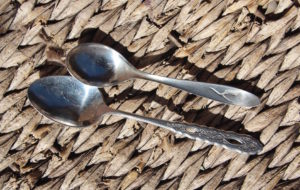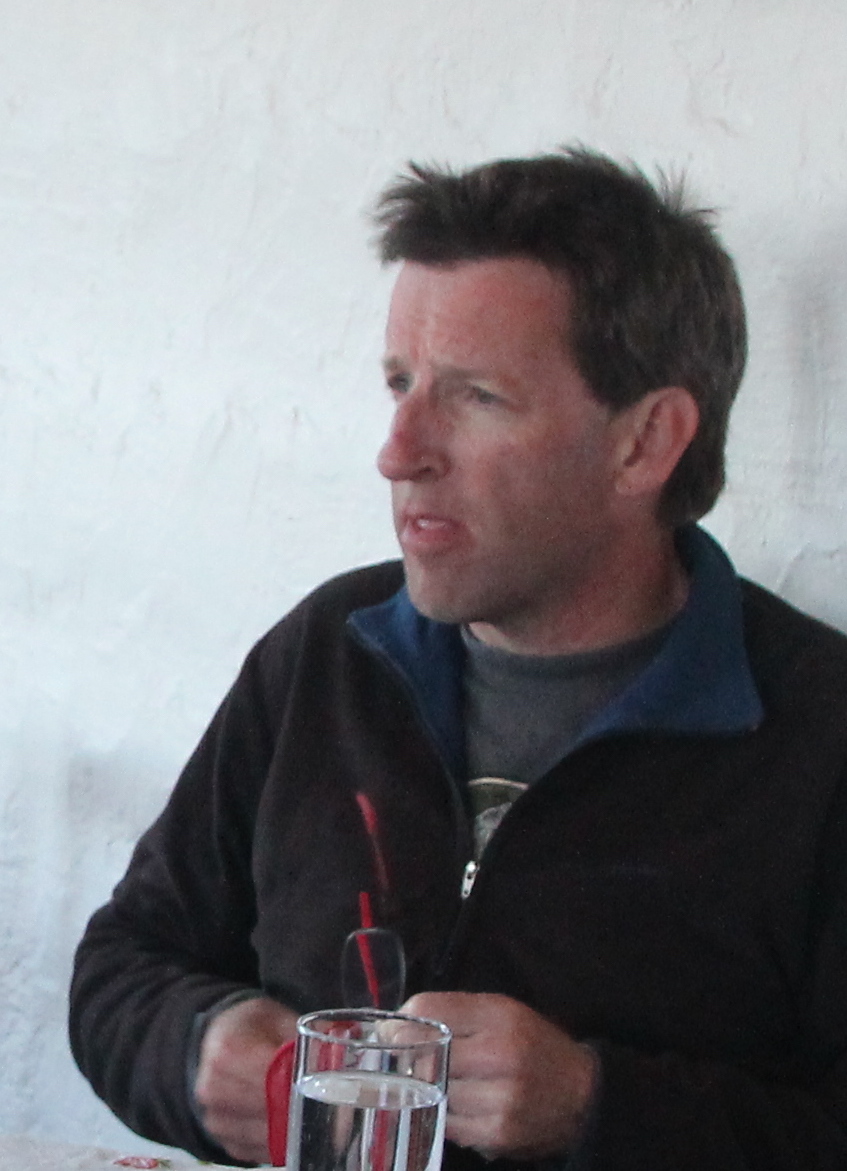 In our family, spoons have come handed down through earth and air.
In our family, spoons have come handed down through earth and air.
The first is easier to explain, as I’m sure the cupboards or other reliquaries of many have been enriched by the addition of silverware from long-dead grandmothers and great-aunts. As have ours. But we have also literally unearthed a few. Every year there is occasion to dig in our rocky Old Town lot, to plant a shrub or root out a tenacious elm or put in a chicken run, and often as not we encounter low-rent buried treasure: an antique bottle once full of Thedford’s Syrup of Black-Draught patent medicine (used as a laxative), a rusty length of chain, or marbles that bespeak an era of kids’ entertainment pre-dating apps and TVs.
And spoons, crusted over with clay and looking nothing like a tea party. But they clean up pretty good. These are ornate flatware with elaborate airy cutouts and floral flourishes, the sorts of spoons to lend an air of civilization to a ramshackle frontier town. Mismatched, they now constitute some of the motley assortment of silverware we keep in the car camping box.
These spoons make me think of the rancher’s daughter I spoke to recently, who told me how in her mid-twentieth-century childhood home the cowboys were always expected to have proper table manners: “Mom would have her book of etiquette, and she had her silverware all out like this, and she would show all the cowboys exactly what to use, and glasses to use, so if they went to a fancy place, they’d know how to do it.”
Spoons are like that, a very explicit mark of civilization, a test of who is in and who is out, the palpable sign of the quantifying mind that measures and doles out and demands a certain level of behavior in return. A teaspoon to go with the coffee or tea implies all of what’s needed to bring the sugar in, whether the once-upon-a-time lashes of slavery or the contemporary pesticides flowing into the Everglades. Maybe you take honey instead, the liquid labor of myriad bees. It’s a spoon as much as any harsher tool that explicitly shows who’s in charge, who belongs and who doesn’t. And it’s spoons that show how thoroughly the notions of measurement and following the routine have invaded our daily lives. Does that recipe call for a pinch or a quarter teaspoon? Does it matter? Maybe, if we want the certitude of precision, the reassurance that someone else has worked out the ratios for us.
I don’t know what those cowboys thought of their spoons-and-glasses drill, whether it was an amusement or a seriously taken lesson in social climbing. But spoons can also become emblems of the tyranny of the domestic. J. Alfred Prufrock felt that, lamenting “I have measured out my life with coffee spoons” in T.S. Eliot’s famous poem about a man who feels overly subservient to the domestic regimes of the early 20th century. Does he dare to eat a peach? No, probably not; it would be too messy. It’s as if the spoons, doled out according to careful household ritual, themselves become the hands on a clock measuring out the wasted hours of a life. In our recent history it’s women who most immediately felt that tyranny, since the men were at least able to get away from the ordering of the spoons—another quality imposed from somewhere outside, from some expert somewhere—and engage with the world of work.
Which is why I’m grateful for our other family spoon heirlooms, the ones that really did arrive by air.
They’re quite the opposite of our ornate yard spoons. These utensils have smooth midcentury modern lines, a simple graceful form that bespeaks a postwar cosmopolitanism—as does the forklike Lufthansa symbol. Like the triple-tailed Constellations on which they were used, there’s a technological sexiness to them, a form-follows-function aesthetic.
My grandmother, an immigrant from Germany, flew those planes back and forth in the ’60s, as did her dearly beloved sisters who’d remained back in the Rhineland. Even though they’d spent almost their entire adult lives in Chicago my grandparents prized their close ties to what they still considered Heimat: homeland. My grandfather fantasized about moving back after retirement; my pragmatic grandmother, who’d put a lot of work into creating a new life in three decades in the U.S., put her foot down about that.
But the visits back and forth, yes.
I love the vision of my grandmother or her sisters flying over the Atlantic, using the elegant spoons to stir their coffee or eat a soft-boiled egg and then carefully pocketing the spoon on each flight. A small act of thievery, yes, though I imagine the cost of replacement silverware was calculated into the price of the ticket.
We don’t use them much. But I was very happy to serve coffee with them when the German cousins came over during the summer. And I like imagining the small rebelliousness this souvenir-taking represents: my grandmother, the glue of the household, the one who did all the cooking and cleaning and most of the care of the children, who probably at times cursed the home rituals of spoons and forks and glasses, slips the elegantly curvaceous spoon into her purse. At least in that brief moment, at four miles above the Earth’s surface, it is not she who has to organize the spoons; instead she gets to feel that small pleasure of coveting, and of taking with her a reminder of the moment when she is free.

